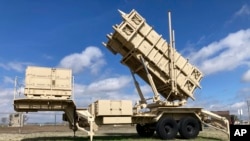The United States provided Ukraine with more than $113 billion in U.S. security and financial aid in 2022 following Russia’s invasion. U.S. lawmakers from both parties have voiced concerns about oversight and accountability concerning that aid.
A March 29 congressional hearing on aid to Ukraine found no evidence of misuse.
In his opening remarks at the hearing, Rep. Michael McCaul, chairman of the House Foreign Affairs Committee, said that conducting oversight is not to question the importance of supporting Ukraine, but to ensure the aid “being used as intended.”
He said:
“Of the 113 billion dollars appropriated across four supplementals, approximately 60 percent is going to American troops, American workers, and to modernizing American stockpiles.
“In fact, only 20 percent of the funding is going directly to the Ukrainian government in the form of direct budgetary assistance.”
On April 2, China’s state-run Global Times newspaper seized on McCaul’s statement and posted a video clip from the U.S. congressional hearing on Weibo, China’s Twitter-like social media platform.
The captions for the video read:
“Chairman of the U.S. House Foreign Affairs Committee confirmed: only 20% of U.S. aid to Ukraine flows to Kyiv, 60% of it is received by the United States itself.”
That is misleading.
Here is how U.S. aid for Ukraine works.
In 2022, the U.S. Congress appropriated more than $113 billion for Ukraine through emergency supplemental funding measures in March ($14 billion), May ($40 billion), September ($14 billion) and December ($45 billion). (Numbers rounded to integers)
- $44.27 billion to support enhanced U.S. troop deployments in Europe, as well as replenish and modernize U.S. defense stockpiles
- $22.73 billion to the U.S. defense industry to supply weapons for Ukraine and European allies and partners facing Russian aggression
- $22.9 billion for Ukraine’s government to help support critical services, such as first responders (which corresponds with McCaul’s “20%”)
- $18.7 billion for humanitarian and other assistance to Ukraine and affected countries, including to address global food security via global partners with U.S. Agency for International Development’s (USAID) Bureau for Resilience and Food Security
- $4.81 billion to other U.S. government agencies implementing Ukraine policy
Mark Cancian, a senior adviser with the International Security Program of the Center for Strategic and International Studies (CSIS), a Washington think tank, concurs with the breakdown provided by the Polygraph.info source.
Cancian says, the U.S. aid to Ukraine falls into four groups
- Military aid
- Humanitarian aid
- Economic support to the Ukrainian government, which goes directly to Kyiv “to allow continuing operations since the war has disrupted its own mechanisms for raising revenue…”
- U.S. government operations costs related to Ukraine, such as expenses for moving embassy personnel, prosecuting war crimes and enforcing sanctions.
Cancian further divided military aid, currently Ukraine’s most pressing need, into four types:
- Short-term military support, which “includes the transfer of weapons, both U.S. weapons and those purchased from allies, training of Ukrainian military personnel, and intelligence sharing.” This category covers “only the backfill equipment sent to Ukraine, not the equipment itself.” (“backfill” will be explained below)
- Long-term military support, which “consists of money that Ukraine can use to buy new weapons, mostly from the United States but also elsewhere.” This category of support “likely funds post-war rebuilding of Ukrainian military, not current operations.”
- U.S. military operations: Since Russia’s February 2022 invasion, the Pentagon has deployed or extended over 20,000 additional troops to Europe in response. Expenses for these deployments exceeded the planned budget of the U.S. Defense Department (DOD). This partly explains what McCaul meant by aid “going to American troops.”
- DOD general support: activities to prepare DOD for future conflicts, “some only tangentially related to Ukraine.”
Cancian told Polygraph.info that about $25 billion worth of defense equipment was sent to Ukraine via presidential drawdown authority, under which President Joe Biden can authorize immediate delivery of defense articles from DOD stockpiles without seeking congressional approval.
“The president is not legally required to replace that, but Congress has provided money to do that,” he said.
The DOD needs to maintain a certain level of inventories for the U.S. military’s war plans and training. Therefore, after sending stockpiles to Ukraine, DOD needs to place orders with the defense industry to replace the equipment sent to Ukraine . Thus, funding for replenishing, or backfilling, DOD stockpiles does go to U.S. workers in the defense industry.
Among the U.S. defense industry’s major companies are Lockheed Martin, Raytheon, Boeing, Northrop Grumman and General Dynamics.
Cancian added that Ukraine also signs contracts with the U.S. defense industry for equipment with money provided in the aid packages:
“That will also go to the U.S. workers, for the most part. Though there are a few things that have some foreign content.”
The U.S. is sending Ukraine older or current versions of its military equipment. That means some of the money allocated for the overall Ukraine aid package will be used to “modernize American stockpiles” – that is, replace the weapons sent to Ukraine with newer and more advanced ones.





